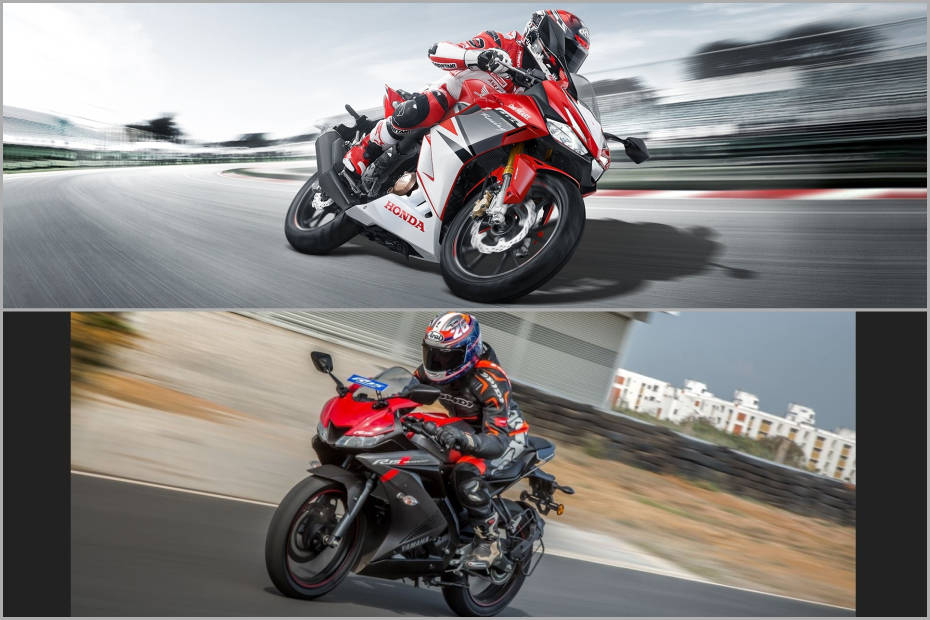2021 Honda CBR150R vs Yamaha R15 V3.0: Specifications Compared
Published On January 16, 2021 15:55 IST
By Praveen M. for Honda CBR150R
- 61305 Views
Does Honda’s latest iteration of its 150cc track tamer have what it takes to take on the legendary R15 on paper?

Honda Indonesia launched the 2021 CBR150R in the country recently. It goes head-to-head against one of the most popular sporty 150cc motorcycles, the Yamaha R15 V3.0. We already know Indonesia has a differently specced R15, complete with an inverted front fork and a less-cleaner engine. But let’s compare the latest Honda CBR150R with the India-spec R15 so that it’s a little more relatable for us enthusiasts:
Engine

Being a smaller-engined motorcycle, the CBR150R obviously makes slightly less power than the Yamaha R15 V3.0, and the peak torque isn’t all that different either. However, the CBR150R’s output comes in earlier down the rev range for more instant performance. While the output delivery of the R15 may be peaky, it has a fantastic trick up its sleeve: Variable Valve Actuation (VVA) technology. This system makes sure there’s a good balance of bottom-end grunt and top-end drive. Both bikes get assist and slipper clutch, which helps in reducing the lever effort and makes sure the rear wheel doesn’t get locked up during aggressive downshifts. They’re quite useful while going downhill or attacking corners at a race track.
Underpinnings

The biggest advantage the 2021 Honda CBR150R has is its premium inverted Showa Separate Function Big Piston Front fork (Showa SFF-BP). This offers a much more sophisticated damping than the conventional telescopic fork in the India-spec Yamaha R15 V3.0. That being said, such a complex fork isn’t really necessary unless the rider often goes on track days, where shaving every tenths of a second counts. This is where the better stability and lower unsprung mass (mass of the suspension, wheels, axles and tyres) offered by the inverted front fork really comes into play.
While both bikes have similarly sized front wheels, the R15 gets a fatter rear rubber with radial construction, which offers enhanced sidewall strength, thereby giving riders greater confidence while pushing the bike to its limits in corners.
Dimensions & Features

Honda has made sure the 2021 CBR150R is as light as it gets. The light kerb weight should go a long way in improving the bike’s agility, performance as well as efficiency in the real world. This coupled with its accessible seat height makes it perfect for shorter riders. The Yamaha R15 V3, on the other hand, impresses with its generous ground clearance, which should come in handy while navigating bad roads.

As far as the feature list is concerned, the Yamaha R15 gets an all-LED headlamp and tail lamp whereas the CBR150R’s lighting system is all-LED. The R15 also gets a fully digital instrument cluster which shows the real time mileage along with other useful run-of-the-mill information like speedometer, tachometer, trip meter, clock, fuel gauge -- just like the CBR150R’s fully-digital instrument cluster. Both bikes get dual-channel ABS but it is available as an optional variant in the CBR150R.
Price & Verdict

In Indonesia, the Yamaha R15 V3.0 retails at an equivalent of Rs 1,88,220 (on-road, Jakarta), which is quite similar to the 2021 Honda CBR150R’s pricing in the country. So when it comes to out-and-out performance, the R15 V3 is an amazing deal not only in Indonesia but also in India. Although, the caveat for the latter part of the previous statement is that the R15 enjoys its position of being the only properly performance-oriented 150cc supersport in India.
But if Honda were to bring the 2021 CBR150R to our shores, its aggressive CBR250R-like looks, premium underpinnings and lightweight dynamics will make sure it has its own fan following in the country. It would be really interesting to see which one would be more popular when Honda decides to grab a piece of pie from the R15’s hand here.
